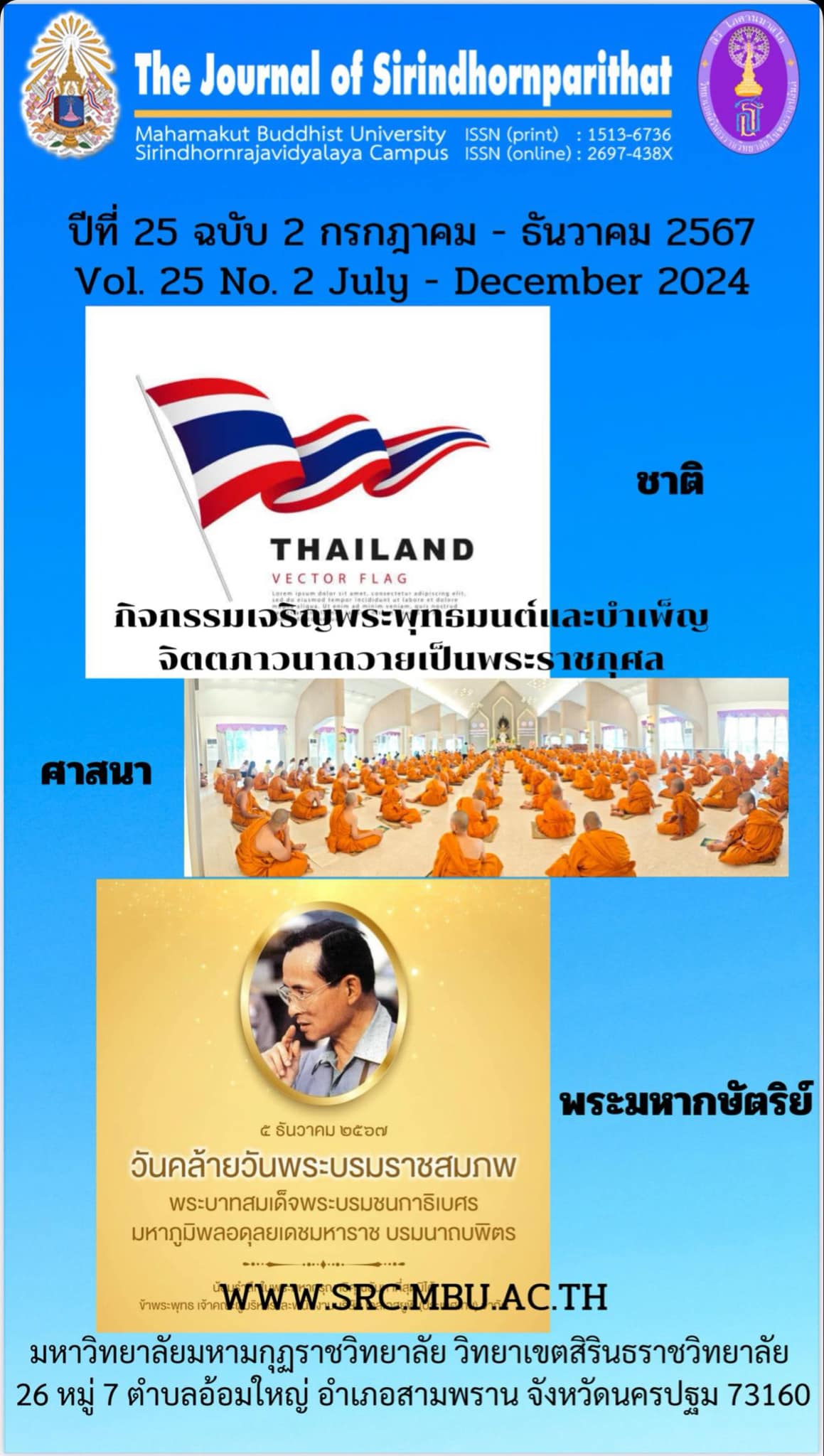The Communication Model Development of The Educational Service Area Office For Developing Education Quality of Schools Under The Official of The Basic Education Commission
Keywords:
Communication model, Educational Development, The educational service area officeAbstract
The purposes of this research were to 1) Study the communication variables of the educational service area offices for educational quality of schools.2) Draft the communication models of the educational service area offices for educational quality of schools. 3) Check the communication model of the educational service area offices for educational quality of schools. 4) Confirm the communication model of the educational service area offices for educational quality of schools under the official of the basic education commission. Using the Delphi technique research process together with Ethnographic Delphi Futures Research. Select a specific informants by set the attributes were Group 1 The 9 experts for interview, Group 2 The 17 experts for Delphi technique and Group 3 The 9 experts for confirm the communication model. The research tools were the Semi-structured interview, questionnaire and assessment form to confirm the communication model. The statistics used for data analysis were frequency, percentage, mean, median, popular base and interquartile range.
The research findings found:
1. The communication variables of the educational service area offices for educational quality of schools canned synthesize 183 variables.
2. Draft communication models of the educational service area offices for educational quality of schools by 9 experts had 184 variables, 5 elements were 1) Sender 2) Message 3) Channel 4) Receiver and 5) Communication Management.
3. Found the communication model of the educational service area offices for educational quality of schools.4) Confirm the communication model of the educational service area offices for educational quality of schools under the official of the basic education commission by 17 experts as follows: 3.1 The component 1, the sender, consists of 40 variables, The average were between 3.71-4.94, median were between 3-5, base values were between 3-5, median-base values were 0, quartiles range between 0-1, demand of the communication model at the highest level were 29 variables, at the high level were 11 variables. 3.2 The component 2, the message, consists of 36 variables, The average were between 88-5.00, median were between 3-5, base values were between 3-5, median-base values were 0, quartiles range between 0-1, demand of the communication model at the highest level were 24 variables, at the high level were 12 variables. 3.3 The component 3, the channel, consists of 30 variables, The average were between 4.12-4.94, median were between 3-5, base values were between 3-5, median-base values were 0, quartiles range between 0-1, demand of the communication model at the highest level were16 variables, at the high level were 14 variables. 3.4 The component 4, the receiver, consists of 31 variables, The average were between 3.41-4.94, median were between 3-5, base values were between 3-5, median-base values were 0, quartiles range between 0-1, demand of the communication model at the highest level were18 variables, at the high level were 13 variables. 3.5 The component 4, the communication management, consists of 31 variables, The average were between 3.88-4.94, median were between 3-5, base values were between 3-5, median-base values were 0, quartiles range between 0-1, demand of the communication model at the highest level were 30 variables, at the high level were 11 variables. 4. The communication model of the educational service area offices for educational quality of schools under the official of the basic education commission that has been confirmed by 9 experts had 5 components were 1) Sender 2) Message 3) Channel 4) Receiver and 5) Communication Management.
References
ชิรวัฒน์ นิจเนตร. (2560). การวิจัยพัฒนารูปแบบทางสังคมศาสตร์และการศึกษา. วารสารราชภัฏสุราษฎร์ธานี. 4(2).
ณัฐิกานต์ ปังศรีวงศ์. (2563). การพัฒนาทักษะด้านการใช้เทคโนโลยีสารสนเทศและการสื่อสารเพื่อการจัดการเรียนรู้ ในศตวรรษที่ 21 ของครูโรงเรียนตลาดหนองหวาย สังกัดสำนักงานเขตพื้นที่ การศึกษาประถมศึกษาสุราษฎร์ธานี เขต 2. สืบค้นเมื่อ 22 มกราคม 2565 จาก http://ir.sru.ac.th/handle/123456789/766
ธนัท สมณคุปต์. (2562). การสื่อสารผ่านสื่อดิจิทัลของวิสาหกิจชุมชน. วารสารเทคโนโลยีและสื่อสารการศึกษา ECT Journal. 16: 11-22.
นพพล นพรัตน์. (2561). 5 ปัญหาการสื่อสารภายในองค์กร. ค้นหาเมื่อวันที่ มกราคม 23, 2565, จาก https://acrosswork.co.th/2018/10/.
แพมาลา วัฒนเสถียรสินธุ์. (2559). ปัจจัยที่ส่งผลต่อปัญหาการสื่อสารในองค์กร กรณีศึกษา บริษัท ยูไนเต็ด แสตนดาร์ด เทอร์มินัล จำกัด (มหาชน). ปริญญานิพนธ์ บริหารธุรกิจมหาบัณฑิต คณะพาณิชยศาสตร์และการบัญชี มหาวิทยาลัยธรรมศาสตร์.
วิเชียร ทรงศรี. (2560). การพัฒนารูปแบบการบริหารเครือข่ายโรงเรียนสังกัดสำนักงานเขตพื้นที่ีการศึกษา ประถมศึกษา. กรุงเทพมหานคร: มหาวิทยาลัยนอร์ธกรุงเทพ.
สุปัญนา เจริญสุข. (2550). ปัญหาการสื่อสารระหว่างผู้บังคับบัญชาและผู้ใต้บังคับบัญชากรณีศึกษา: ข้าราชการสังกัดสำนักงานเขตพื้นที่การศึกษาสกลนคร เขต 3. ค้นหาเมื่อวันที่ 2 เมษายน 2565, จาก http://Google.com.
อมรรัตน์ จินดา. (2559). สภาพปัญหาและแนวทางส่งเสริมการใช้เทคโนโลยีสารสนเทศและการสื่อสารเพื่อการศึกษาสำหรับสถานศึกษาในสังกัดสำนักงานเขตพื้นที่การศึกษาประถมศึกษานครปฐม เขต 2. Veridian E Journal. 9(1).
Good, Carter V. (1973). Dictionary of Education. New York: McGraw–Hill Book Company.
Downloads
Published
Issue
Section
License
Copyright (c) 2024 Mahamakut Buddhist University

This work is licensed under a Creative Commons Attribution-NonCommercial-NoDerivatives 4.0 International License.
บทความที่ได้รับการตีพิมพ์เป็นลิขสิทธิ์ของ มหาวิทยาลัยมหามกุฏราชวิทยาลัย วิทยาเขตสิรินธรราชวิทยาลัย
ข้อความที่ปรากฏในบทความแต่ละเรื่องในวารสารวิชาการเล่มนี้เป็นความคิดเห็นส่วนตัวของผู้เขียนแต่ละท่านไม่เกี่ยวข้องกับหาวิทยาลัยมหามกุฏราชวิทยาลัย วิทยาเขตสิรินธรราชวิทยาลัย และคณาจารย์ท่านอื่นๆในมหาวิทยาลัยฯ แต่อย่างใด ความรับผิดชอบองค์ประกอบทั้งหมดของบทความแต่ละเรื่องเป็นของผู้เขียนแต่ละท่าน หากมีความผิดพลาดใดๆ ผู้เขียนแต่ละท่านจะรับผิดชอบบทความของตนเองแต่ผู้เดียว



